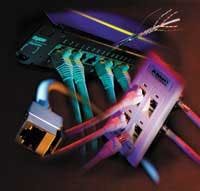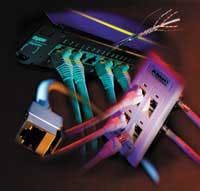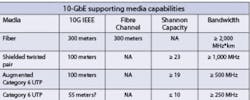What you need to know to make an informed, intelligent decision.
oday, the only standards-based LAN solutions for 10-Gigabit Ethernet (10-GbE) are optical fiber and twinax cable (two-conductor coaxial cable). Now, the Institute of Electrical and Electronics Engineers (IEEE; www.ieee.org) is working to define a 10-GbE standard on balanced twisted-pair copper cabling for the developing 10GBase-T Standard (IEEE 802.3an).
While 10-Gigabit applications are uncommon to date in most locations, end users want to install cabling now that will support 10-Gigabit in the future. In an ideal world, the migration to 10-Gigabit would be seamless, meaning 10-GbE would run on existing cabling infrastructures up to a distance of 100 meters on balanced twisted pair and up to 300 meters on multimode optical fiber. Standards already enable fiber solutions to 300 meters, but the 100-meter distance on twisted-pair media has been difficult to define.
Despite 10-GbE performance requirements not yet being fully defined on twisted-pair media, the industry is experiencing a continual stream of new product announcements and performance claims for twisted-pair products. Trying to make sense of the claims, evaluate them logically on an even playing field, and select the best choice for migration to 10-GbE makes for an interesting challenge.
Each of the three options available-fiber, shielded twisted pair (STP), and unshielded twisted pair (UTP)-offer advantages and disadvantages, so there is no one right answer. Designers, installers, and end users can all benefit from knowing what’s fact, what’s hype, and what they need to know to make an informed, intelligent decision.
Standards status
Systems backed by existing industry standards offer designers, installers, and end users value and peace of mind by ensuring interoperability, performance guarantees, and network expansion. Standards-based solutions limit the possibility of becoming locked into a proprietary solution that may not survive over time.
In February 2002, the IEEE 802.3ae standard was published with four LAN variants for optical fiber. 10GBase-SR supports 10-GbE to 300 meters at the 850-nanometer (nm) wavelength on 850-nm laser-optimized 50-µm multimode fiber. 10GBase-LX4 supports 10-GbE to 300 meters at the 1310-nm wavelength on 50- and 62.5-µm multimode fiber using four singlemode lasers and wave division multiplexing. 10GBase-LR supports 10-GbE to 10 kilometers but operates only on singlemode fiber, and 10GBase-ER supports 10-GbE to 40 kilometers only on singlemode fiber.
In April 2002, TIA/EIA TR-42.8 published 568-B.3 Addendum 1 listing the transmission performance specifications for 850-nm laser-optimized 50-µm multimode fiber. In September 2002, ISO published standards for 10-GbE transmission on OM1, OM2, OM3, and OS1-type optical fiber.
So, 10-Gigabit Ethernet applications and standards for optical fiber are well established.
The 10GBase-CX4 standard published much later, (February 2004), defined a 10-GbE application on twinax cable. But because this application is limited to 15 meters, it’s not considered a LAN application.
In defining a 10-GbE standard for balanced twisted-pair copper cabling, one of the objectives is to enable 10-GbE up to 100 meters on ISO Class E cabling that is appropriately “augmented.” Therefore, TIA/EIA TR-42 is working with the IEEE to define “Augmented Category 6 unshielded twisted-pair (UTP)” through Addenda 10 and 11 to 568-B.2 projects. At this point, there is no officially adopted timeline for either of these documents, but the IEEE 802.3an is still clinging to a publication date of June 2006.
Although “Augmented Category 6 UTP” cabling is not yet recognized by any published standard, several solutions are being introduced into the market. On the other hand, shielded Category 6 twisted-pair (STP) is already a recognized medium under ISO and TIA/EIA (568-B.2-1). In addition, shielded cable (Class F) has already been defined by ISO/IEC 11801 to a frequency of 600 MHz, which is higher than what will likely be required for 10-GbE.
Of the available options for 10-GbE, optical fiber is the only standards-based LAN solution, with cabling and electronics in use in the market for more than three years. Optical fiber, therefore, has a significant head start on cost reductions and product development over twisted pair. Since STP as a medium is already defined in TIA and ISO, it is ahead of the standards game as compared to the still-developing Augmented Category 6 UTP solution. STP has been widely deployed and a proven solution for many years throughout much of the world, and it is now gaining ground here in North America. Augmented Category 6 UTP is in its infancy, with industry standards still pending and performance and interoperability parameters not yet defined.
Performance perspective
The number one concern among designers, installers, and end users is system performance. Of the three 10-GbE options, optical fiber offers the greatest transmission distance and most bandwidth potential. Today’s multimode optical fiber supports two variants of 10-GbE (10GBase-SR and 10GBase-LX4) and Fibre Channel to 300 meters. Fiber cable is also lighter and has a smaller diameter than copper cable, and it offers complete immunity to noise and better security from unauthorized tapping.
Many parameters are used to define performance in twisted-pair copper systems. The increased bandwidth required for 10-GbE signaling alone is not the answer. With 10-GbE, the higher frequencies produced by the electronics generate considerable noise that has to somehow be controlled. Alien crosstalk (ANEXT) is caused by these high-frequency signals coupling between adjacent copper cables and connecting hardware. As the newest and most critical parameter of concern with 10-GbE, ANEXT is the limiting noise source for running 10-GbE over copper.
Shannon Capacity, measured in gigabits per second (Gbits/sec), defines the maximum amount of data that can be transmitted in the presence of noise as determined by the signal-to-noise ratio. The foil shielding of an STP system virtually eliminates ANEXT, resulting in a higher signal-to-noise ratio and a much larger Shannon Capacity compared to Augmented UTP tested under the same conditions. In fact, under nominal test conditions, Category 6 STP has an ANEXT improvement of 20 dB and Shannon Capacity improvement of 4 Gbits/sec over current versions of Augmented Category 6 UTP.
In addition to providing immunity to ANEXT, STP systems are the ideal solution for many applications. STP’s foil shielding makes it resistant to EMI and RFI. In noisy environments, this equates to fewer spurious spikes and system interruptions, as well as noise reduction from non-cable sources.
While Augmented Category 6 UTP will likely support the pending 10-GbE standard to 100 meters, Augmented Category 6 UTP cable manufacturers are having difficulty meeting projected power-sum ANEXT requirements of the pending standard, and so the limits may have to be relaxed. Tests show Augmented Category 6 UTP to demonstrate minimally compliant Shannon Capacity and minimally compliant ANEXT. So, it’s easy to conclude that STP should support 10-GbE easily and that Augmented Category 6 should support 10-GbE marginally. Existing Category 6 UTP, characterized to 250 MHz, may be limited to channel lengths much shorter than 100 meters for 10-GbE.
Cost comparison
Optical fiber has long been considered too expensive; however, costs for fiber installation and components have decreased dramatically over the past decade. The cost of a complete, centralized optical-fiber system can be as little as 5% more than a traditional Category 6 UTP install. Optical-fiber cabling offers the maximum port utilization and highest density, resulting in overall cost savings.
Historically, however, the industry has preferred copper solutions. UTP solutions in North America have been more popular than STP primarily due to product cost. Other considerations, such as installation hours, density, and grounding/bonding issues, have also had an influence. While STP product cost and installation time carry a premium over today’s UTP equivalents (i.e., Category 6 UTP), that is not necessarily the case when compared to Augmented Category 6 UTP products now hitting the market.
The historical perspective that “UTP is cheaper” may no longer apply when looking to 10 Gigabit. To reduce ANEXT, Augmented Category 6 solutions have been designed with a larger overall cable diameter to move pairs further away from the cable jacket, which also results in a stiffer and more expensive cable and in decreased density in cable trays, conduit, cable management, and cable routing.
Because the Augmented Category 6 UTP standard is not yet defined, implementing these systems also carries the risk of not meeting standards in the future or becoming locked into a proprietary solution. This risk factor, combined with density premiums, can end up putting the estimated cost of an Augmented Category 6 UTP channel higher than an STP channel. Unlike fiber, however, STP and UTP solutions use the same electronics, so there is no premium for network equipment.
Before purchasing a 10-GbE solution, examine all the options and review the facts to determine the best, most cost-effective solution.
HERB CONGDON IV, director, fiber systems marketing; BOB ZAHR, RCDD/LAN Specialist and systems engineering manager; and BRIAN DAVIS, manager, copper products, are with Tyco Electronics/AMP Netconnect (www.ampnetconnect).





